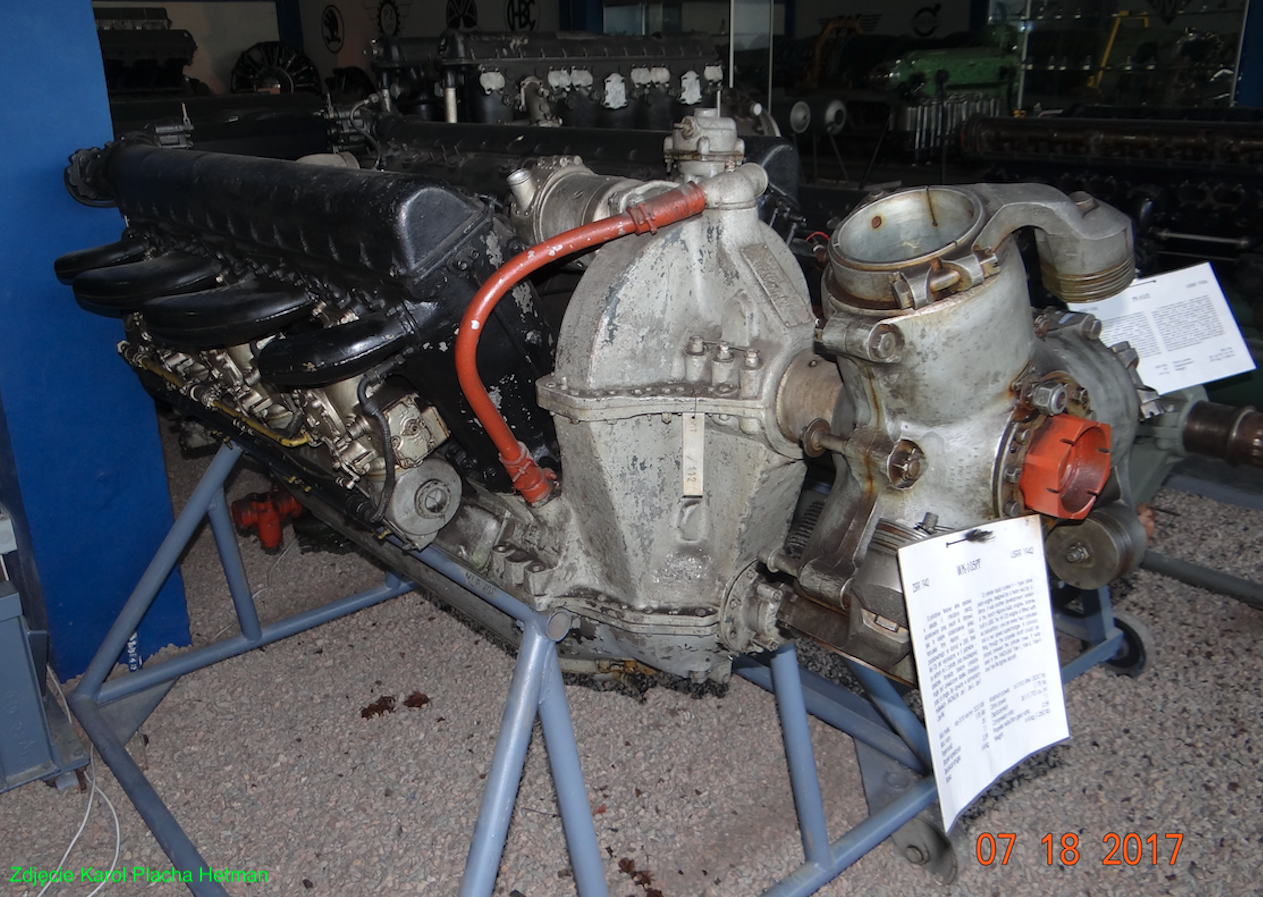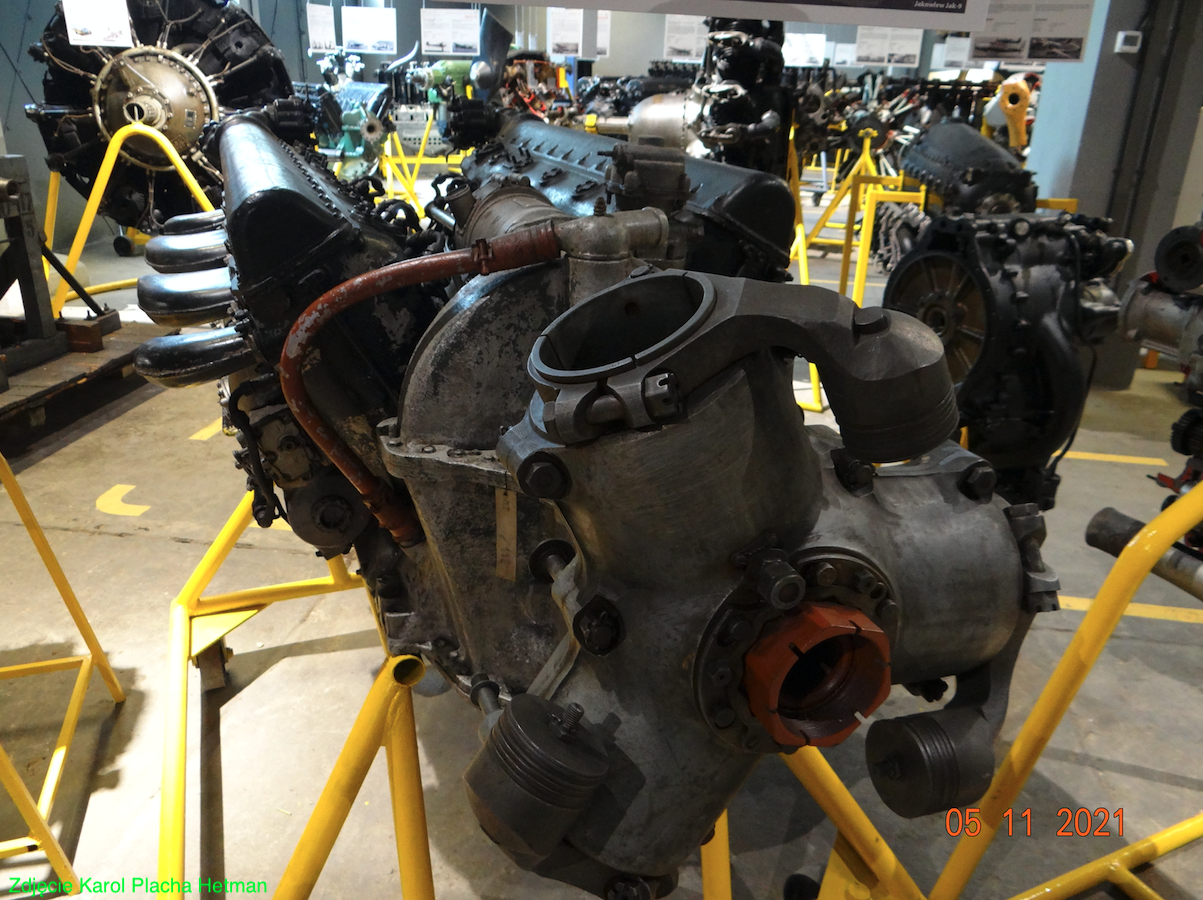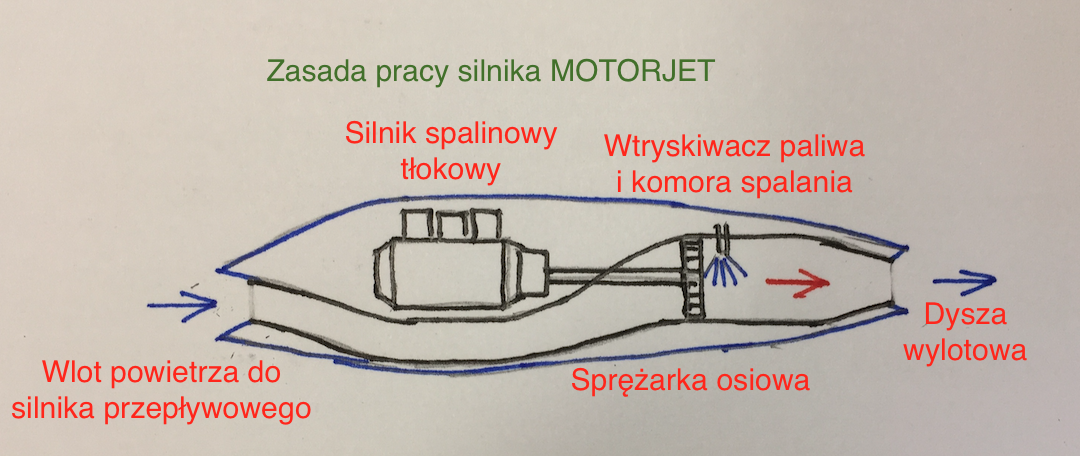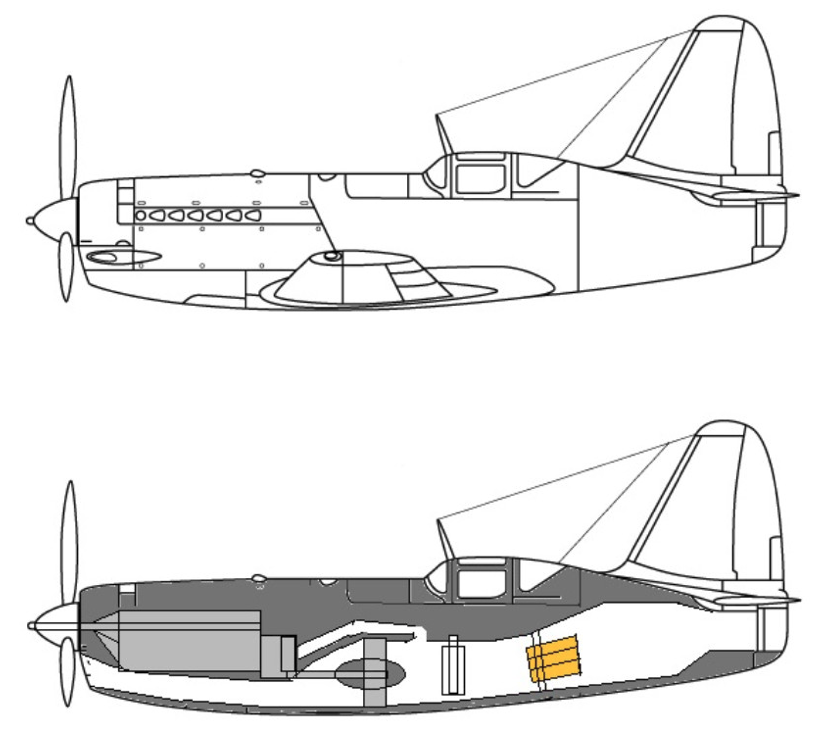Kraków 2016-06-26
Motorjet engine
Photo description: This converted engine, designated WK-107 R, was used to power the jet compressor in the I-250 aircraft.
Jet propulsion.
Airplane jet propulsion is a colloquial term currently used to indicate that we mean a turbojet powered airplane. Although there is a much larger range of jet propellers. A jet engine is a rocket engine and a pulse engine, and modern airplanes do not have such. I will try to explain why this happened.
In the previous chapters we drew attention to the fact that already in 30 years it is impossible to reach a speed of 700 km / h with a propeller drive. The problem is precisely the propeller. It is highly efficient as long as the blade tips do not exceed the speed of sound. When they exceed this speed, the propeller’s efficiency drops drastically, so the plane slows down. And the increase in the rotational speed of this propeller will not help here. The development of a propeller with narrow ends to eliminate supersonic phenomena in the 90s of the 20th century does not help much.
The search for another form of propulsion has begun. There were many fantastic ideas. However, they all headed towards the jet propulsion. Ultimately, the following types of engines were developed: rocket, motorjet, jet, pulse and turbojet. They were all developed more or less at the same time. The latter have become the primary power source for modern aircraft. All of this will be discussed.
A bit about old history.
As early as in the 16th century, Leonardo da Vinci made a sketch of a chimney in which windmills would be mounted, moved by flowing smoke. In 1629, Giovanni Brance developed the construction of a hammer mill driven by the recoil of steam escaping under high pressure. In the years that followed, at least a few steam engines were developed that used a jet of water vapor under pressure. There were, among others, this type of engine adapted to the propulsion of airships or rail vehicles. This was the time when humanity entered the "Age of Steam".
In 1910, Romanian engineer Henri Coanda constructed and built the world’s first jet-powered airplane. The plane was equipped with a piston engine with relatively low power. The engine did not move a typical propeller, just a type of bladed rotor which was covered with a tunnel. Behind the rotor there was an injection of additional fuel to increase the power of the power unit. During the taxiing tests, the designer started the entire power unit. However, the pilot noticed that the flames were unusually large and the skin of the plane started to burn. The pilot did not even notice that the machine broke off the ground. There was almost no disaster. After this incident, the designer abandoned further work on this invention. The event is so significant for Romanians now that their international airport is named after Henri Coanda. This idea was revived after 20 years.
Italian achievements.
It would seem that only the English and Germans worked on jet engines. However, the Italians also had considerable achievements. One of the great figures of Italian aviation was Giovanni Battista Caproni (1886-1957). He was the creator of the first Italian plane (1910), the first bomber plane in the world (1914), the first large passenger plane taking 100 passengers (1920). Giovanni Caproni built his planes in his own Società Italiana Caproni factory, which he founded in 1908. Over time, the name of the company has changed several times.
The airframe of the plane was extremely modern. Full metal low wing with retractable landing gear. What was missing was that the undercarriage had a front support, not a rear tail wheel. Hull in the form of a long tube with a two-seater tandem cabin, completely covered. The power unit was a motorjet (piston-jet engine). The drive unit started with a central, circular air intake, behind which was a central inlet cone directing air to the annular channel. Then there was a 3-stage compressor. The compressor blades have a variable pitch angle. The compressor was driven via a gearbox by a downstream piston engine. It is an Isotta Fraschini L.121 RC.40 engine with 900 HP (670 kW), built in a two-row, 12-cylinder, liquid-cooled system. The air duct bypasses the engine, crew cabin, hull fuel tank. Further on, there is a combustion chamber to which fuel is fed through the injectors, which creates thrust while burning. The combustion chamber ends with a diffuser and an outlet nozzle. The thrust force was adjusted and accelerated by a cone in the outlet nozzle. Campini called his powertrain "termojet". The inventors made trials with various fuels: kerosene, diesel and others.
Motorjet.
What is a motorjet, a reciprocating jet engine? The motorjet consists of a compressor (usually radial) which is driven by a reciprocating engine. Usually it was a radial piston engine. Compressed air in the chamber received fuel injection. The resulting mixture caught fire. The rapidly expanding gases escaped through the discharge nozzle in the form of a jet and produced draft. For a given power of a piston engine, the thrust of such a power unit is much greater than a propeller would give. Sometimes this engine was called the Campini engine, from its creator. In today’s nomenclature, it is a duct compressor with an afterburner.
This type of propulsion turned out to be less efficient than turbojet engines. The main reason was too little air pressure and higher fuel consumption. The drive unit itself was more complicated. Nevertheless, this system worked and drove the plane effectively. Its advantage was the lack of a turbine. The element that is the most difficult to manufacture, and therefore it is costly in production due to high loads and high temperature operation. Another advantage was the single combustion chamber, not the pitcher or ring chambers. It was also easier to cool the chamber from the outside, so it could withstand higher operating temperatures.
Experience in CCCP. MiG I-250.
The Russians developed mixed drives without giving up a typical propeller. At the core of this philosophy was the desire to achieve temporary high speeds without sacrificing the advantages of a propeller plane. The more malicious say that technical backwardness was at the root. In our opinion, the reason was simply the lack of a turbojet engine. Nevertheless, in this way the Russians developed some interesting structures. The most famous are the I-250 and Su-5.
The office of OKB Mikojan and Guriewicz started work on the propeller-jet plane in May 1944. The aircraft was designated I-250, and in production the MiG-13. The combined drive consisted of the WK-107R in-line piston engine (a modification of the WK-107A engine) used in the Jakowlew Jak-9 P and the Jakowlew Jak-3 already produced after the war. A 3-blade propeller with a diameter of 3.1 m was used. In this system, the jet engine was a motorjet engine marked WRDK, with a thrust of approximately 4.3 kN. The reciprocating engine primarily drove the propeller, but also through the gearbox and shaft the engine, in fact the WRDK compressor. Both power units (piston engine and mtorjet) ran on the same fuel. The total conversion power of the drive unit was 2,560 HP (1,882.87 kW). The power of the WK-107R engine is not fully known. According to various sources, it ranges from 1,250 hp to 1,500 hp, except that the power of 1,500 hp was achieved by the WK-107A engine, which did not have a WRDK transmission. The Airplane, on the other hand, was made as an all-metal low-wing.
WKRD (BKPД) – Air jet compressor engine. Воздушный компрессор воздушно-реактивный двигатель.
The first plane was designated I-250. The design was ready on March 28, 1944, the wooden mock-up was ready on October 26, 1944, on November 30, 1944, the detailed documentation for the prototype was ready. The prototype was built in the winter of 1944/1945 and at the end of February the plane underwent airport tests. On March 3, 1945, the plane with the designation I-250-01 painted white and named "White Night" took off for the first flight. Aleksandr Diejew sat at the controls. The motorjet was put into operation for the first time in its third flight. However, subsequent flights had to be interrupted and the tail had to be corrected, which turned out to be ineffective. After the tail modification on May 23, 1945, the I-250-01 aircraft reached a speed of 825 km / h at an altitude of 7,800 m. In the next flight, pilot Aleksandr Diejew died when part of the tail broke off the plane. The pilot managed to jump out, open the parachute, but the distance from the ground was too small. The impact of the motorjet was significant. On the piston engine alone, the plane reached a maximum speed of 677 km / h. The analyzes showed that the jet propulsion added 30% of the power to the powerplant. However, fuel consumption increased drastically.
The second prototype of the I-250-02 received a reinforced structure, enlarged tail and many other minor changes. Aleksei Yakimov was flying in the plane. The plane was painted navy blue with yellow stripes on the fuselage and was called "Blue Stocking". The WRDK engine, however, was only an accelerator. It could only be run for 2-3 minutes. The total working time did not exceed 10 minutes, after which it was fit only for renovation. Regardless of whether the afterburner was running or not, the compressor was always spinning. The idea was that there was no air jam in the air channel, which would significantly limit the speed of the plane. The speed of the compressor was approximately 30,000 rpm. According to the data, the WRDK thrust was 4.3 kN. The conversion power of the entire power unit is approximately 2 560 KM. (I would like to point out right away that converting the sequence to power is not that simple, because there is no ordinary mathematical equation and it is calculated for a specific case.)
The plane was difficult to pilot because the flight characteristics changed when the motorjet engine was turned on. In addition, piloting imposed additional activities on the pilot. The ground handling of the aircraft itself was longer than that of the classic machine and required additional knowledge, skills and equipment.
The most surprising thing about the propulsion system was the propeller being left behind, which as such is the main problem in reaching speeds of over 700 km / h. This proves the conservative approach of the designers to new power units at that time. Trials of the I-250 lasted three months and it was decided to build a series of 50 machines, even though the plane was still underdeveloped. The planes were put into trial operation in military (sea) aviation and served until 1950. Probably 10-15 examples were built, and a few others were in different conditions of assembly. The military designation is MiG-13, which was probably issued in absentia. In OKB MiG the plane was codenamed "N". The machines were heavier than the experimental planes, because they received weapons and a communication radio station. As a result, they had worse performance and a much longer inrun. The MiG-13 aircraft had a negligible range due to the small amount of space for a fuel tank in the fuselage. Therefore, already at the stage of serial production, the MiG-13 received an additional internal fuel tank with a capacity of 190 liters. The total amount of fuel to be transported thus increased to 780 liters. The range increased to 780 km without the use of the motorjet drive. This, however, worsened the take-off and speed characteristics of the plane again, as the plane was taking off only with the propeller drive. Initially, the plane was armed with 1 cannon and 2 MG, which were converted to 3 20 mm cannons. The MiG-13 aircraft never went to state trials. Its operation was very time-consuming and complicated. The machine was difficult to pilot, and when the jet engine was turned on, the flight characteristics changed significantly.
Suchoj Su-5.
An identical task – to build a fighter plane with a mixed drive, a 12-cylinder WK-107R piston engine with a power of 1,225 kW and a WRDK motorjet engine with a thrust of 3-4 kN – was awarded to the Suchoj team. The plane was marked Su-5, and the designation in the office I-107. The plane was very similar to the MiG-13. However, it differed in several details. A 4-blade propeller with a diameter of about 2.9 m was used. The conversion power of the entire power unit is about 2,600 HP.
The pilot’s cabin occupied the central part of the fuselage. The plane was planned to be equipped with 1 NS-23 23 mm (100 rounds) cannon firing through the propeller’s hub and 2 MGs placed in the wings of the Berezin UB 12.7 mm (200 rounds).
The prototype of the first flight was made on April 6, 1945. The maximum speed of 810 km / h was reached at an altitude of 7,800 m. During the tests, the piston engine overheated and seized up. The lack of a replacement WK-107R engine resulted in aborting the tests and the program was suspended. With the appearance of the MiG-9 and Jak-15 turbojet aircraft, work on the I-250 and Su-5 was completely abandoned.
The mototjet engine proved to be undeveloped. It had a large total weight due to the use of a piston engine. Compressor efficiency was limited due to too low rotational speed. It had high fuel consumption and low thrust. The total cross-section of the piston engine and the air duct is large, which results in difficulties in the installation of the power unit and poor aerodynamic characteristics of the fuselage.
Today’s literature states that the motorjet was a replacement, which is not true. The problem was that this was the same direction in the search for a new propeller "without a propeller" as turbojets, jet engines and rocket engines. Simply one of these directions turned out to be better (turbojet engine) and dominated aviation. Although, in truth, he did not completely dismantle the propeller in aviation.
Written by Karol Placha Hetman




